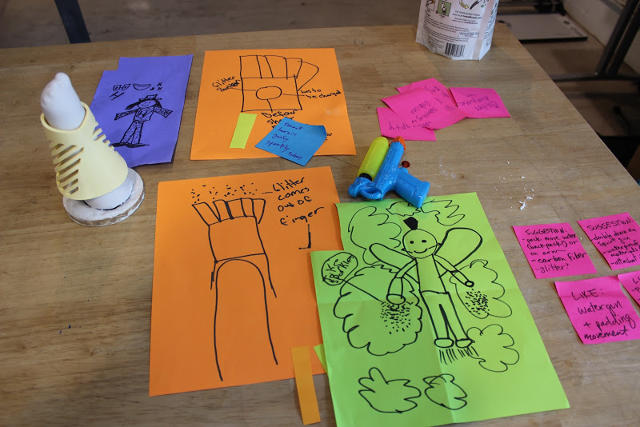“This pushes the bubble, and it blows up sparkles,” Jordan explained as she demonstrated the mechanism behind her creation, a glitter-blasting arm. Born with a left arm that stops just above the elbow, Reeves created the prosthetic arm cannon at the Superhero Cyborgs 2.0 program in San Francisco, a workshop hosted by non-profit KIDmob and 3-D software firm Autodesk. The program connects children between the ages of 10 to 15 with upper-limb differences with professional engineers so that they can design and create their own custom-made prosthetics that do, well, whatever the kids want them to do. Co-director of KIDmob, Kate Ganim says of the workshop, “For us, our interest is in getting kids familiar with taking an idea from concept to execution and learning the skills along the way to do that. Ideally, it’s not about the end product they end up with out of workshop; it’s more about realizing they’re not just subject to what’s available on the market. It creates this interesting closed loop system where they’re both designer and end user. That is very powerful.” Reeves felt delighted to be picked for the program, which only has enough spots for a few participants. “I was like, ‘Wow, I can’t believe I’m actually doing this,’ ” she said in an interview with Fast Company. Jordan’s mother, Jen Lee Reeves, described the struggle to find a comfortable, good prosthesis for her daughter over the years — one that’s become a bit easier with the advent of 3D printing. “We’ve always encouraged the growth of 3-D printing, because it’s more affordable. I feel like the engineers building these hands are really great, but they don’t know the body. There’s a revolution that’s emerging where doctors and experts with degrees that help the body need to know more about hacking the body with more affordable tools.” Jen Lee Reeves is the founder of Born Just Right, an online platform for parents of disabled children to share their stories and find support. Jen called the experience “another amazing one-handed opportunity,” saying it was just another reason Jordan is able to keep a positive attitude. “She isn’t sad about living with one hand. It’s a blessing,” she wrote. “How many kids with two hands can say they have a bunch of extra hands?”
Five days into the 10-day program and with the help of a 3D-printed prototype, Jordan had her design down: a cuff that can be slipped over the wearer’s arm. Known as “Project Unicorn,” the cannon blasts glitter out of five separate barrels, using a trigger wrapped around manual air compressors. While Reeves is still working on making the glitter travel a great distance, the concept is about as cool as it gets. As of now, the arm cannon still needs a bit of work — in Jordan’s words, the glitter “just kinda [spills] out” from the barrels. “But who cares?” she says. “It’s fun and it’s exciting and it’s a really cool way to empower kids.” However, Jordan and her designer still have six months to play around with the design and create perfected prototypes. Sam Hobish, an Autodesk designer, has partnered with Jordan to help her realize her project and make it the best it can be, even if it takes longer than the allotted six months. “I’ve been talking to my colleagues in electronics and materials development about ways we can create some kind of pressurized system that shoots out sparkles more effectively … I plan to work until we get something she really likes. If that means we make new prototypes over the course of a year, I’m fine with that. I’ll keep going until someone tells me to stop,” said Sam. He’s also helping Jordan create a modular arm that can do other, more useful things. Reeves, who came up with her Unicorn Project to help spread joy and happiness to those around her, is also hoping to develop a 3D printed and affordable prosthetic she can use on a more regular basis, to help her to hold a cellphone, and to help her parents with everyday chores like carrying the groceries. Watch 10-year-old Reeves describe how her #SuperheroCyborg Glitter-Shooting Arm works in the video clip below.
